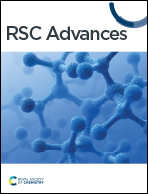The influence of sample mass (scaling effect) on the synthesis and structure of non-graphitizing carbon (biochar) during the analytical pyrolysis of biomass†
Abstract
The porous non-graphitizing carbon (NGC) known as biochar is derived from the pyrolytic conversion of organic precursors and is widely investigated due to its multifunctional applications. At present, biochar is predominantly synthesized in custom lab-scale reactors (LSRs) to determine the properties of carbon, while a thermogravimetric reactor (TG) is utilized for pyrolysis characterization. This results in inconsistencies in the correlation between the structure of biochar carbon and the pyrolysis process. If a TG reactor can also be used as an LSR for biochar synthesis, then the process characteristics and the properties of the synthesized NGC can be simultaneously investigated. It also eliminates the need for expensive LSRs in the laboratory, improves the reproducibility, and correlatability of pyrolysis characteristics with the properties of the resulting biochar carbon. Furthermore, despite numerous TG studies on the kinetics and characterization of biomass pyrolysis, none have questioned how the properties of biochar carbon vary due to the influence of the starting sample mass (scaling) in the reactor. Herein, with a lignin-rich model substrate (walnut shells), TG is utilized as an LSR, for the first time, to investigate the scaling effect starting from the pure kinetic regime (KR). The changes in the pyrolysis characteristics and the structural properties of the resultant NGC with scaling are concurrently traced and comprehensively studied. It is conclusively proven that scaling influences the pyrolysis process and the NGC structure. There is a gradual shift in pyrolysis characteristics and NGC properties from the KR until an inflection mass of ∼200 mg is reached. After this, the carbon properties (aryl-C%, pore characteristics, defects in nanostructure, and biochar yield) are similar. At small scales (≲100 mg), and especially near the KR (≤10 mg) carbonization is higher despite the reduced char formation reaction. The pyrolysis is more endothermic near KR with increased emissions of CO2 and H2O. For a lignin-rich precursor, at masses above inflection point, TG can be employed for concurrent pyrolysis characterization and biochar synthesis for application-specific NGC investigations.



 Please wait while we load your content...
Please wait while we load your content...